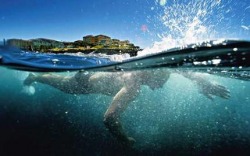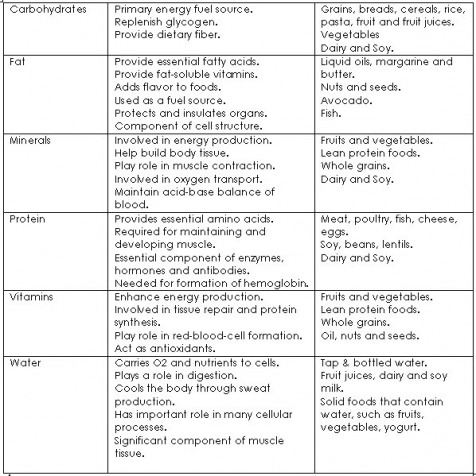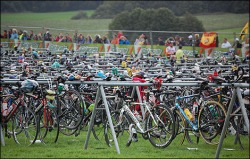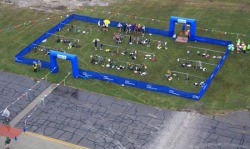Interview by: Nicole Pisani
I caught up with Coach Olivia Lord post IMAZ to ask her a few questions about her second Ironman. She tells us about her race experience, and what life was like for her leading up to race day.
What brought you to IM Arizona?
OL: To be honest – it was the timing! As a mom it can be a struggle to balance training, kids, work etc. My youngest Poppy started full day kindergarten in September, so it seemed like the perfect time to jump back into IM training!
What expectations did you have going in?
OL: When I sat down and planned out my year, my races and what I wanted out of my season I set myself some pretty aggressive goals for this race. I designated it as my one and only A race for the season – a risky move because it puts a lot of pressure on that one day, but I knew that given my busy life there was no room for another important race so I put all my eggs in the IMAZ basket. I wanted to take an hour off my IMLP time (yup – an HOUR). I was looking for improvement across the board and I assumed that I could gain some time from the flatter course.
Are you happy with your race result?
OL: YES!!! Can you see my smile from here??
Tell us about your day.
OL: Get comfortable – this could take a while!!
My day started at 4:00 a.m. with more food than anyone should eat at 4:00 a.m.!
It was chilly and dark once we arrived at the Iron Village got my bike packed with nutrition and computer and a quick tire check. By the time I was lined up to get in the water (with 2800 of my closest buddies) the sun was starting to come up and the excitement, fear and nausea in the air was palpable!
My swim was not awesome – Tempe Town Mud Pond, err Lake, is so murky that you’re swimming blind. I took some good knocks including a double dunking, goggle removal resulting in a calf cramp that took my breath away! But here’s the thing about Ironman, rough things are guaranteed to occur at some point during your day – you have to deal to with efficiently and move on – physically and mentally! I glanced at my watch as I rounded the last buoy and realized I better hustle to beat last year’s time – so I did!
Into T1 - I was able to stay outside the tent (always my preference) and quickly got myself ready to ride.
I love the bike – and this course, though crowded, is really fun! It takes about 5 turns over 4-5 miles to get out of town and then you hit the Beeline Highway – straight shot out into the desert – cacti, rocks, the real deal! IMAZ is flat – I knew I could make up time on the bike, of course when I looked down at my Cycle-Ops Joule to see where my watts were – BLANK. Foolish me had let it ’charge’ on an unplugged computer. I had my Garmin but it wasn’t reading power either – so it was me and my average speed! Yep – another opportunity for changing the plan on the fly and rolling with it. I was enjoying the bike, happy with my pace, loving the 3 loops where I got to see my awesome family 3 times!! My nutrition was spot on. The last loop was very windy – a solid headwind all the way back into town – and a lot of drafting, which I steadfastly avoided (and caught most of them when their pack disbanded – Ha!).
Off the bike – VERY happy, I came in about 15 minutes faster than I had anticipated – yeah!
Quick T2, loo stop (couldn’t pee on the bike – too many people!!!) and off on the strange triple figure 8 run course. The run is never my strength; I struggled mentally and had a hard time getting my head back in the game. I knew my pace was off, even though my Garmin died (not a great day for technology!). I actually thought I was getting faster as the race went on, not so! It just seemed that way because by the time I was on my 3rd loop most of the folks I was passing were walking – making my slow jog feel like a zippy run!
I drank water and coke, sucked on oranges and forced down my GU and salt caps – no tummy issues. I had no idea what time it was until the last 2 miles when I heard a guy ahead of me say to his buddy – we can break 11:30 if we keep this pace. Great! Seeing 11:19 on the clock as I finally ran toward that finish line was a huge surprise – I was one enormous blubbering smile! I found Matt and Kelly and John and my saint-like handler held me up as I cried and grinned!!!
You mentioned wanting to really make gains with your running. How did you feel during the AZ run?
OL: During the run I felt like ok, steady, not great – BUT in retrospect I think it was my mental state not my physical one that held me back. I did not *believe* that I had the run in me that I wanted, all kinds of excuses – too hard on the bike, not a natural runner… all kinds of negativity that I listened to and allowed to rule my run. I know I have a better run in me – I believe it now and I will conquer that!
How much training do you manage in one week?
OL: In a high volume week, 15-18 hrs. In a typical week, 10-15.
Of the three disciplines of triathlon, which one do you consider your strength?
OL: BIKE :)
Talk about a typical day in your life, if you can.
OL: In a word - busy! Now that the kiddos are in school I sleep in – till 6, then up for coffee J Making lunches, waking kids, making breakfast, dressing kids, packing backpacks, finding homework, yelling upstairs a lot for everyone to hurry up, waiting for the bus, waving goodbye – then I get to train! That workout changes depending on what day it is, on my long bike day I would wave goodbye to the bus, get on my bike and make it home just in time to meet the bus again! But typically I’m out for a run from the house, to the pool or on the trainer. Then off to work, home for the same routine as breakfast (just backwards – getting them back into bed!!) and working on my coaching clients workouts. I try to keep my evenings free of workouts – I’ll get up 3 hrs earlier if I have to. I really appreciate the downtime, blobbing out for a bit in front of the telly, allowing myself to be a bit lazy!
You did an Ironman in 2009 and then AZ. What should we expect to see you sign up for next?
OL: I’m working on that…. don’t be surprised to see 2012 include another IM (despite what I said all year!!)
So which of these two Ironman's did you enjoy more and why?
OL: Hands down IMAZ – The first time you do anything you learn so much, and you suffer so much! I felt like with AZ I was able to utilize the lessons learned, and I felt that way all through the training (thanks Nicole!) – Stronger and more aware of my capabilities.
Anything else we should know?
OL: For me IMAZ was a breakthrough race, yeah it was faster, but that’s not why. I finally started to believe in myself during IMAZ. I am so excited for the future, I can’t wait to start training again, to push myself further and harder and see what happens.
Transition – the 4th discipline!
It is a skill to be able to swiftly move between swimming, biking and
running and like any other it must be practiced.
Brick workouts will help you physiologically adjust to moving between
disciplines, and setting up mini transition areas will help with this.
TA things to think about in training:
Swim to Bike
- Run from water to bike to simulate your elevated heart rate on race
day
- Lay out your shoes, helmet, glasses etc as you will on race day
- Practice running with your bike while wearing cycling shoes.
- Practice removing your wetsuit!
Bike to Run
- As you near the end of your ride go into an easier gear and start
spinning at a higher cadence (100-120 is good) this will increase the
blood flow to your legs.
- Try a few ‘spin ups’ cycling into as high a cadence as you can and
focusing on the pull of your pedal stroke not just powerful down
stroke.
- Move quickly into your run as though you were at a race – it’s hard
to be fast sometimes at home – resist the urge to pop inside or get a
glass of water – we’re aiming for a realistic transition feeling.
- Start your run with quick cadence and a light step – it will probably
hurt a bit for the first few hundred meters – don’t let it stop you, the
weird feeling will go away and pretty soon you’ll just be running.
How to set up your TA:
- Some races will assign you a spot on a bike rack, others will let you
choose your own (another benefit to being early – pick an end
spot!).
- Hang your bike on the rack front wheel in, handlebars over the
rack. If you have a mountain bike or straight bar hybrid turn the bike
around, back it under the rack and hook your saddle over the bar.
- Lay down your small towel and place your race gear on it, go in
order of events – at the front of your towel place your cycling shoes
(Velcro open, ready for feet) socks - one in each shoe.
- Put a little talcum powder in your shoes and socks and they will slide
on easily when your feet are wet.
- Lie your helmet on your shoes, straps open, put your sunglasses
inside – open and ready to put on.
- Behind that place your running shoes and hat
Remember that your transition area is your home base, it should reflect these two words - Easy and Efficient. If anything is your TA is unnecessary - remove it, hand off to your support crew/adoring fans!
Run Training:The great thing about running is that we all know how to do it! Swimming is technique focused, cycling requires gear – running is almost instinctive and as such is the most basic part of the tri. However, running can lead to injuries more easily than swimming or biking. If you are a new runner take it slowly, remember that your muscles need time to develop to protect your joints, a little discomfort after early runs is normal, remember to stretch after running and warm up before you head out. Your triathlon training program should incorporate speed, power and endurance into it’s run training plan – be careful to spilt them up through your week so as not to overload your body. Running form:- Aim for efficiency in your form – triathlon is all about preserving energy. - Lean forward slightly, from the ankles not the hips. - Be mindful of running smoothly – try to reduce bounce which is just wasted energy. This can be done by increasing your cadence. - Aim for a cadence of 80-90 rpm, count steps for 15 seconds and multiply by 4, shoot for 20-23 steps. - Hold your arms at a 90 degree angle, relaxed but engaged. - Move arms back and forth not across the body The best running form is a natural one, if you are having trouble try these drills: - Take your shoes off and sprint 100m on soft grass (remember what it felt like to run as a kid!) - Do short hill repeats (find a hill it takes you 1-2 mins to run up, about 5-6% grade) run up and walk down. Notice that both drills correct your form, try and remember that feeling in your regular running.
Bricks:Running after biking feels quite different to stand alone running and needs to be practiced. The way we train for this combination of muscle fatigue and muscle confusion is by doing BRICKS. A brick workout is a combination of 2 or more elements of tri. People have many different theories for why these workouts are called bricks – because you’re legs feel like bricks – bike + run = ick… the list goes on. - Start with a short 10-15 minute run or walk run after a 30-45 minute bike, keep the run easy, aiming for heart rate zones 1-2 - Weekly increase the time of your run (by no more than 10% each week) - Build up to sprint race distance. The bike to run brick is the most important, the more experience you have running ‘off the bike’ the more your muscles will adapt to it and the less fatigue you will experience. As you do more bike to run bricks you will see how important it is to save something for the run and not hammer your bike ride – it’s all a matter of balance. Gear:A decent pair of running shoes – that’s it! Go to a good running store (like The Runner's Alley in Portsmouth, NH) for a gait analysis, it’s worth the money and your body will appreciate it! A pair of elastic laces (Yankz) are great for getting in and out of shoes quickly. And a hat or visor makes tri running more pleasant. If you experience chafing while running use a lubricant like Body Glide, good stuff! It can also be used around your feet to reduce the risk of blisters (especially if you're not wearing socks!).
Bike Training:
The bike leg is where the true balance of triathlon becomes evident. The
bike leg is the most important part of your race, it takes up the most time,
it’s smack in the middle and it can make or break your run.
Your bike training will make up the bulk of your training volume, you
should incorporate at least one longer ride per week, covering (for sprint
distance races) at least the distance you need to cover in the race.
Cycling is a great part of your training because it is directly beneficial to
your muscular endurance and overall fitness gains without the impact on
your body that running can have. Bike training can be used for recovery
work as well as for workouts where you are pushing your thresholds.
During your training take time to practice eating and drinking while on
your bike. Get used to reaching for your water bottle and the gels in your
pockets. It is much easier to digest while riding than while running so it
makes sense to get as much as your fuel in while you are on the bike.
Get to know your bike! By doing the basic bike maintenance yourself you
will learn the different parts of your bike, where the cables go and what
everything does. You can clean your bike, de-grease, oil and lube without
any technical skills! Learn how to fix a flat – a flat tire is no fun and there
are few things more annoying than feeling completely helpless as you
wait for someone to pick you up (assuming you have a cell phone, and
cell coverage!). Changing a tire is easy and the more you do it the
quicker it gets! Some races have bike support cars that drive the course
and will help you out – IF they see you, but there is no guarantee that their
timing will coincide with your flat.
Gear:
More than you can shake a carbon fiber stick at!
A bike! For your first tri all you need is a reliable bike that fits you. However
if you are looking at bikes here are some things to know.
- Most bikes are made of 1 of 4 different materials, steel, aluminum,
titanium and carbon. Each material has it’s pros and cons e.g. steel
is strong but heavy, carbon is light and stiff but expensive. The
material your bike is made of is of less importance than the way it
fits you.
- At a triathlon you will typically see 3 types of bikes. Road bike,
triathlon (or time trial) bike and mountain bike. Any of these can be
used in a tri.
Road Bikes: (a great way to get started in cycling and tri)
- A road bike is designed to be ridden with hands on the hoods of the
handlebars, brakes and gearing within reach.
- The ‘drops’ – the lower part of the handlebars are only used when
you’re really hauling!
- Road bikes are probably the most common type of bike at
triathlons, they are a versatile bike that can be used for racing and
are great for group riding.
Triathlon Bikes: (a good fit for long distance triathletes)
- The geometry of a TT bike is designed for the rider to be leaning
down on the aero bars, with a seat tube angle of 76-78 degrees
which places the rider into a more forward position.
- The shifters on a TT bike are at the end of the aero bars, the brakes
are still on the handlebars.
- Being aero is most advantageous on long distance rides and flat
courses where you have the most to gain from being more
aerodynamic.
*Many triathletes attach clip on aero bars to their road bike, a
compromise that works well as long as the fit is adjusted.
Mountain Bikes: (designed for off road but totally ok if that’s the bike you
have!)
- A mountain bike is less efficient on the road because of it’s wide
nubby tires, suspension (front or dual) and it’s weight.
- They are not unusual at sprint tris!
- If you are a mountain biker looking to branch out - check out an
XTERRA
Bike Fit:
Having the right size frame is the most important part of your bike fit, with a
bike that is too small or too big you will be uncomfortable on your bike,
not be able to push as hard or go as far, in short if it doesn’t fit – don’t ride
it!
Figure out your frame size, even if you don’t plan to buy a bike right away
it’s worth asking a cyclist friend to help you find your size (bike sizes are
measured in cm by the length of the top tube).
Once you have been riding a while it’s worth looking into getting a
professional bike fit, especially if you are having any discomfort while
riding (numb palms, repetitive soreness in any spot, knee pain).
Wheels & Tires:
There are 2 main kinds of tires, clinchers and tubulars. Clinchers are the
most common - a tire with a tube that fits inside it, the sides of the tire
“clinch” to the wheel.
Tubulars are a tube and tire combined that is glued to the wheel – these
can be hard to change!
Stick to clinchers unless you have a lot of time to practice working with
tubulars!
Either tire needs air! Pumping your tires and checking their pressure should
become a part of your pre-ride routine. Know your pressure, too little and
the wheel won’t roll easily – but too much and you will bounce!
The basic pressure guidelines are:
Clinchers 100-120 lbs./sq inch.
Tubulars 120-140 lbs. /sq inch.
Remember that air expands when it gets warm – be careful inflating your
tires in the cool early morning before a race as the heat of the day may
lead to over-inflation.
Which wheel?
Spoked wheels are good all around wheels for training and racing, some
spokes are now flat, and there are a lot less of them than in bikes of the
past! You can spend a lot of money upgrading wheels, from carbon
‘deep dish’ rims to full disks. But before you pull out a second mortgage
on you home keep in mind that most gains found from race wheels are
found once the rider is averaging above 20 mph. If you’re looking to buy
speed, expensive wheels are not always the best bang for your buck.
Helmet:
Gotta have one! All USAT sanctioned races require helmets (buckled!)
that are ANSI approved.
Any (safe) helmet will do, try them on and find the helmet that fits your
head and your budget. You will see all kind of helmets at races – including
the point aero helmets that look like they could puncture your spinal cord!
Just an FYI – as funny as they look, aero helmets are often the biggest
bang for the triathlete’s buck when looking to “buy speed”. It has been
estimated that once an 18mph average has been reached an aero
helmet can give up to a mile an hour of free speed. Just food for thought,
there are more toys in tri than just about any other sport!
Pedals and Shoes:
Shoes are required on the bike. Your running shoes will do, or you can
move into an integrated system of clipless pedals and shoes. The benefits
of ‘clipping in’ are a greater transfer of power throughout the entire pedal
stroke – not just the push down but also the pull up, a more direct transfer
of power from the stiff sole of a cycling shoe (not the absorbent rubber of
a running shoe), and safety as you are less likely to slip on your pedal if
you are clipped to it.
Clipless pedals do take a little getting used to, take it slowly and they will
soon become second nature.
- Practice clipping in and out with one leg on the ground, then swap
legs
- Go to a flat grassy area, cycle a short distance then clip out,
practice on both sides.
- On the grass, practice coming to a sudden stop, have a friend yell
“stop!” at random times.
- On your first road ride be very aware of possible reasons to stop and
clip out early. If you see a stop sign – clip out and coast toward it.
- If in doubt – Clip out!
Other Gear:
Decent tri or bike shorts (more on these later)
Sunglasses – a bug in the eye could cause an accident.
Bike gloves – only if you have pain in your palms.
A moisture wicking shirt, bike jerseys are good because they have
pockets.
A seat pack for your flat supplies and cell phone.
The bike and all it's gear makes up a very large part of triathlon, not only in training time but also budget! Make friends with your local bike shop, buy a few really good pieces, they'll last longer and be more comfortable.
Swim training:
Ah, the swim… everyone’s favorite!
Triathlon swimming can be nerve racking to many, but there are lots of
ways to make it easier, less stressful and even fun!
The first step is to become comfortable in the water – practice, practice,
practice. If you are entering triathlons with no swimming background at all
then take some lessons, you don’t need to know all the fancy strokes or
even how to flip turn. But a few solid lessons will set you up with the basics
of freestyle and some tools for training.
Once you are comfortable you can start improving your form and
becoming more efficient. There are many drills that will help you in this
process, it’s an on-going one. Form drills will help every swimmer, speed
will come because as your form improves you will become more efficient
in the water and be faster!
Open water swimming:
Most triathlon swims will take place in open water, lakes, oceans, canals…
It is important to train in open water to get used to the difference
between a lit pool with a guiding black line and a lake!
For safety go with a buddy and take a flotation device (tow it behind).
Practice sighting, before you start pick out a landmark (a tall tree, house,
tower) lift your head to sight after a breath every 5-8 breaths – see how on
course you are! Like most parts of swimming, maintaining a straight line
takes practice.
Gear:
- Swimsuit
- Goggles
- Cap (for the long haired folks)
- Wetsuit, this is not strictly necessary but if you live in a cool climate
(NE!) it is great to have a wetsuit, you may even find some races
require wetsuits. Choose a triathlon specific wetsuit, they are
designed for swimming and are thinner in the arms with more
floatation in the lower body. If you are not a confident swimmer you
may find a wetsuit to be a great help, the added buoyancy helps
keep the body in a more hydrodynamic position in the water and
you can float without working.
TRAINING PLAN BASICS
A triathlon specific training plan will set you on the path to tri success.
If you are coming to triathlon from a running or cycling background (most
common) or even a swimming past (less common!), with a decent level of
fitness, you will be able to get through a sprint tri. However the biggest
gains in tri training are seen through consistency. Following a triathlon
training plan for as little as 8 weeks leading up to a race will bring you to
the start line far better prepared than random workouts will.
Things to look for in a tri training plan:
- A plan that fits your life – no-one can follow their plan 100% but it’s
best to start with a realistic schedule to give yourself a chance!
Think about how many days a week you have some time to train,
how many hours on those days – work out a weekly total and go
from there. Be honest!
- A plan that incorporates recovery and rest periods. Your body
needs recovery time to rebuild the muscles you are stressing – if
every day has a hard workout your performance will diminish.
- A plan that pays special attention to your personal limiters.
- A plan that includes BRICK workouts. A brick is two consecutive
workouts, most often bike to run.
- A plan created by a person! You may have to pay a little extra but
having someone to check in with is a great tool. If you encounter
difficulties a coach can help you through them.
A few other things that can help your training along:
– A training buddy can be a great source of encouragement and
support. Rope a friend (with a similar life schedule) into entering your
tri, training together can push you further than you may go alone.
– Good time management! Life is busy and incorporating three sports
into an already crammed schedule can be a challenge. Look at each
week and decide what time of day you are going to fit in each
workout. Ask your family for support and let your workmates know
what you are up to.
– Be consistent. You don’t have to workout 7 days a week, but with a
measured and consistent approach to training you will see great
fitness gains.
– Log your training, there are lots of free online training logs out there, it’s
great to see how far you’ve come!
Check out
www.ontri.com
www.trainingpeaks.com
www.dailymile.com
NUTRITION BASICS
(A basic overview as nutrition relates to training, for more detailed &
personalized information on diet see a Registered Dietitian)
Eating well:
Most of us know the basics of eating well, if you have a balanced healthy
diet there is no need to change your eating habits when you start tri
training. If you feel like your regular diet is lacking then you may want to
consider making some positive changes in your diet as well as your
training! A healthy diet is particularly important for athletes to fight off
colds and flu, maintain good energy levels and avoid injury.
Water: the essential nutrient
H2O is necessary in daily life but even more so while you are training. It is
key to figure out a hydration strategy that works for you, there are loads of
products out there to help you hydrate on the run – a basic sports water
bottle will fill most needs.
How much water to drink? Check out your pee – if it’s dark yellow you
need more water, if it’s light you are properly hydrated.
Pre-workout:
This is the time for easily digestible carbs. The best time to eat is about 2
hours before your workout – this is not always practical so make sure you
know a few things you can eat before training that sit well in your
stomach.
During workouts:
Water, sports drinks and sports gels. Your main goal is to replace lost fluids
and electrolytes. In shorter distance racing you don’t need to worry too
much about replacing calories – training nutrition becomes extremely
important during longer distance races. Sodium losses from shorter
distance training can be replaced by most sport drinks, supplements may
be needed in extremely hot temperatures or during long distance training
and racing. Keep in mind that some gels and chews have caffeine in
them, if you don’t drink coffee or ‘use’ caffeine in your regular life then be
wary of trying a caffeinated product while you’re working out.
Post workout:
Immediately after exercising try and take in a recovery drink of fast
digesting carbs (chocolate milk works great!) this will restore some of the
muscle glycogen you just used up and start the recovery process. Then
within 60-90 minutes eat a good meal with wholesome carbs and protein.
This window is important, after 90 minutes your body is far less receptive
the absorbing the nutrients and you will take longer to recover.
A note about Carbohydrates.
Triathletes should appreciate that carbs are the body’s major source of fuel, the low/no-carb lifestyle does not often work well with training. If your carbohydrate intake does not provide a sufficient amount of fuel for your workouts and recovery you will not perform at your best. Don’t break out the wonder bread just yet! There are many ways to eat a diet rich in carbs that is also low in gluten and sugar.
A carbohydrate can be simple (one or two molecules) or complex (with up to thousands of molecules). Simple carbs, often called “sugars” are easy to digest and have their place especially while training or racing. While simple carbs have been demonized they are not all bad a more useful way of distinguishing carbs is between refined and wholesome. Fruits contain simple carbohydrates but are jam-packed with nutrients. Whereas products made from refined white flour contain complex carbs but far fewer vitamins and minerals.
LAY OF THE LAND
Each course will be unique, but most races share a basic set up.
The Transition area is your home base, this is a central area with bike racks set up. It is typically situated near the swim finish, bike start & finish and the run start. Transition is where you store your gear, you will rack your bike here before the race and keep all your race equipment with it (more info on setting up your amaking them speedy in an upcoming post).
The basic triathlon formula is this:
Transition
Swim
Transition
Bike
Transition
Run
Finish.
Some races will have multiple transition areas, point to point races will often require athletes to have a support crew to ferry their gear around. But in your basic sprint tri the TA will be something like this -
-An entrance from the swim
-An exit to the bike
-An entrance from the bike
-An exit to the run
Your bike will have it’s own little spot, and you will be able to snag a small area to the side of it to lay out your gear – be considerate – be a tidy triathlete!
Most TA’s are for athletes only, you will have to leave the cheering squad at the gate. Typically you will go through your body marking and then show this to be let into the TA.
You will not be allowed to remove your gear and bike from the TA until the last cyclist has come in from the bike course. Be patient, cheer them in!
Body marking is where you have your race number written onto your upper arm, thigh (just above the knee) and your age marked on your calf (for all to see!). This is for identification purposes – so they can look up your number if you are leading the race! It’s also fun to check out people’s ages as you pass them.
Depending on the size of the race, the TA could be intimate or enormous! If you find yourself in a large TA with many bike racks make sure you have a system to find your bike again! People tie balloons and ribbons to their bikes, others simply count racks. Some TA's have labeled bike racks so you can remember your rack - like a parking garage!
TA things to remember:
-Enter and Exit through the correct gates (avoid potential collisions!)
-Don't mount your bike until you are out of the TA, and dismount before you re-enter TA
-Buckle your helmet before you leave the TA (very important - grounds for DQ!)
-Don't forget to take off your helmet before you start the run (yes- it's happened!)
During your tri, TA is home, make yourself comfortable!
The rules...
No, not like the dating rules - theses are specific race rules set out by USAT!
While you don't need to devote too much time to commiting these to memory, it is a good idea to read over them and store them in the back of your brain.
GENERAL RULES - No bandits (no racing without an official race entry) - No leaving trash or gear on the course - No outside help (except from race or medical officials) - No glass anywhere on the course - No nudity (even in transition area) - No unsportsmanlike conduct or foul language on course - No headphones on course at any time The penalties vary for each infraction, or the number of infractions, including time penalties, disqualification (DQ) or ejection from the race. Swim Rules - Any swim stroke is permitted - If you need to rest you may hold onto a kayak but it can not move you forward in any way. - No gloves, snorkels, fins or flotation devices - In most races if you do not complete the swim within the time limit you will not be permitted to continue. Bike Rules (there are lots!) - Only helmets approved by the US Consumer Product Safety Commission (CPSC) may be used in USAT sanctioned events. Helmets must be worn at all times while on your bike. This means before, during, and after the event. - Helmet straps must be buckled at all times when on a bicycle. - Drafting--keep at least three bike lengths of clear space between you and the cyclist in front. If you move into the zone, you must pass within 15 seconds. - Cyclists must keep to the right hand side of the lane of travel unless passing.- Once passed cyclists must move out of the draft zone immediately - All competitors are required to follow the prescribed course and to stay within all coned lanes.
- Cyclists shall not cross a solid yellow center line for ANY reason.
- Cyclists must obey all applicable traffic laws at all times.
- Handlebars must be plugged.
- Cyclists must mount and dismount at the specified areas.
Run rules (less of these!)
- Wear your race number on your front at all times on the run course.
- Stay to the right.
Don't worry - triathlon can still be fun!!! the rules are all in place to keep participants safe. Triathlon is one of the only sports where everyone competes together on the same course. Professional athletes and first timers all experience the same ups and downs in the race, and are all subject to the same rules!
Next week - the lay of the land!
This is part one in a series of Tri Basics. We'll cover it all, choosing, buying, training, racing, eating, drinking, resting - the whole tri spectrum!We start here, with a little explanation about what a triathlon consists of and the logistics of a race.
EVENT BASICS
Triathlon: n.An athletic contest in which participants compete without stopping in three successive events, usually swimming, bicycling, and running.
There are 4 basic distances:
Sprint: 500m swim / 12 mile bike / 3.1 mile run
Olympic: 1500, swim / 40k bike / 10k run
½ Ironman: 1.2 mile swim / 56 mile bike / 13.1 mile run
Ironman: 2.4 mile swim / 112 mile bike / 26.2 mile run
There are generally some variations on sprint tri distances but the others are typically standard.
The order of events in triathlon is swim, bike, run. There are many multisport races that substitute different elements e.g kayak for a swim, or add more such as a trail run or mountain bike leg. Some adventure races carry on over multiple days and include orienteering and map skills.
An XTERRA is an off road triathlon, consisting of the basic swim, bike, run - but putting it all in the woods! So after the swim athletes complete a mountain bike leg and then a trail run.
The governing body of the sport of triathlon is USA Triathlon. USAT is the sanctioning authority for most races, they have a detailed set of rules and regulations, the basics are listed here but for more specific information check out www.usatriathlon.org USAT requires a one day license to be purchased for each USAT sanctioned race ($10), if you are planning to race 4 or more times in a year you are best off buying an annual license ($40). 1 day licenses can be purchased when you register for your race and annual licenses can be attained through USAT.
USAT determines race categories. Most folks race as ‘age groupers’ this simply means you race against other people who are the same age and gender as you are. Generally the age breakdown is 19 and under, 20 – 24, 25 – 29, 30 – 34, and so on. To make it really confusing, USAT considers your age to be whatever age you’ll be during each calendar year. For example, if you’re going to be 36 on July 1st, you race as a 36 year-old all calendar year whether the race is before or after your birthday. There are sometimes other catgories such as First Timers, Athenas (women over 150 lbs) & Clydesdales (men over 200 lbs).
Next time... The rules!
|








 RSS Feed
RSS Feed